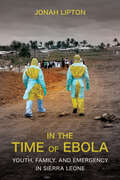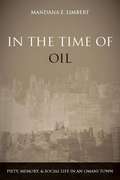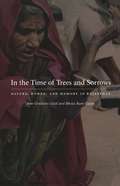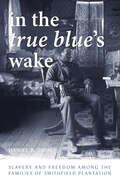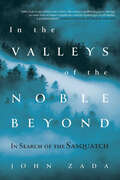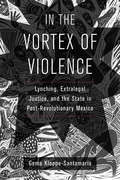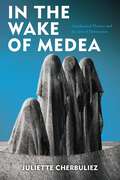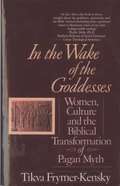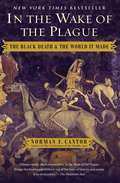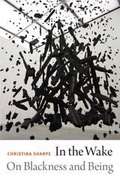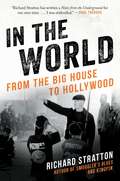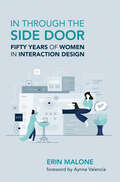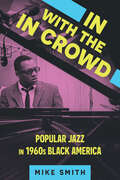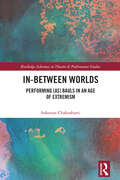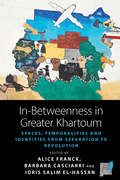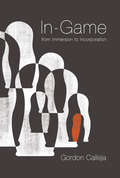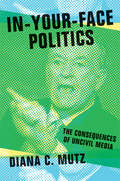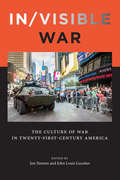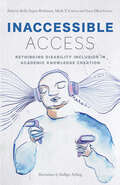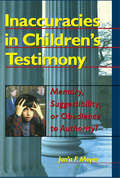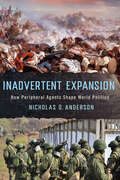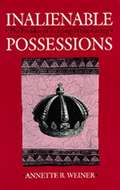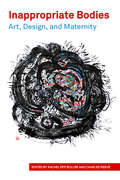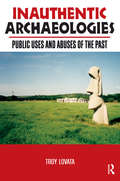- Table View
- List View
In the Time of Ebola: Youth, Family, and Emergency in Sierra Leone
by Jonah LiptonThe anthropologist Jonah Lipton was in Freetown, Sierra Leone, when the largest Ebola outbreak in history hit. In the Time of Ebola is his account of the epidemic, centering on the residents of a neighborhood swept up in the emergency.Lipton follows the lives of young men and women over a period of seven years, revealing what the epidemic looked like on the ground. He explores its causes, impacts, and legacies in a place where crisis might be considered the norm, not the exception. The emergency was disruptive and challenging, not least due to the short-term international response. Yet for many youths Ebola was a time of unusual clarity on the ambiguities around care, work, and coming of age experienced in a context of vast economic and social inequalities. Lipton shows how residents of this historically cosmopolitan West African city drew on centuries-old frameworks for managing foreign intervention. In the Time of Ebola questions dominant framings of crisis and offers ways of theorizing, researching, and responding to emergencies that make the home, the family, and "ordinary life" their starting point.
In the Time of Oil
by Mandana E. LimbertBefore the discovery of oil in the late 1960s, Oman was one of the poorest countries in the world, with only six kilometers of paved roads and one hospital. By the late 1970s, all that had changed as Oman used its new oil wealth to build a modern infrastructure. In the Time of Oil describes how people in Bahla, an oasis town in the interior of Oman, experienced this dramatic transformation following the discovery of oil, and how they now grapple with the prospect of this resource's future depletion. Focusing on shifting structures of governance and new forms of sociality as well as on the changes brought by mass schooling, piped water, and the fracturing of close ties with East Africa, Mandana Limbert shows how personal memories and local histories produce divergent notions about proper social conduct, piety, and gendered religiosity. With close attention to the subtleties of everyday life and the details of archival documents, poetry, and local histories, Limbert provides a rich historical ethnography of oil development, piety, and social life on the Arabian Peninsula.
In the Time of Trees and Sorrows: Nature, Power, and Memory in Rajasthan
by Ann Grodzins Gold Bhoju Ram GujarIn the Time of Trees and Sorrows showcases peasants' memories of everyday life in North India under royal rule and their musings on the contrast between the old days and the unprecedented shifts that a half century of Indian Independence has wrought. It is an oral history of the former Kingdom of Sawar in the modern state of Rajasthan as it was from the 1930s to the 1950s.Based on testimonies from the 1990s, this book stands as a polyvocal account of the radical political and environmental changes the region and its people have faced in the twentieth century. Not just the story of modernity from the perspective of a rural village, these interviews and author commentaries narrate this small rural community's relatively sudden transformation from subjection to a local despot and to a remote colonial power to citizenship in a modern postcolonial democracy. Unlike other recent studies of Rajasthan, the current study gives voice exclusively to former subjects who endured the double oppression of colonial and regional rulers. Gold and Gujar thus place subjective subaltern experiences of daily routines, manifestations of power relations, and sweeping changes to the environment (after the fall of kings) that turned lush forests into a barren landscape on equal footing with historical "fact" and archival sources. Ambiguous, complex, and culturally laden as it is in Western thought, the concept of nature is queried in this ethnographic text. For persons in Sawar the environment is not only a means of sustenance, its deterioration is linked to human morality and to power, both royal and divine. The framing questions of this South Asian history revealed through memories are: what was it like in the time of kings and what happened to the trees?
In the True Blue's Wake: Slavery and Freedom among the Families of Smithfield Plantation (The American South Series)
by Daniel B. ThorpIn 1759, William Preston purchased sixteen enslaved Africans brought to America aboard the True Blue, an English slave ship. Over the next century, the Preston family enslaved more than two hundred individuals and used their labor to establish and operate Smithfield Plantation in Blacksburg, Virginia. Daniel Thorp uncovers the stories of the men and women who were enslaved at Smithfield, one of the first plantations west of the Blue Ridge Mountains, between its establishment in 1774 and the abolition of slavery there in 1865 and offers powerful biographies of their descendants after emancipation.In the True Blue’s Wake is the first book to chronicle the lives of the enslaved families whose labor was crucial to the success of the Prestons, a family that played a central role in the European settlement of southwestern Virginia and produced dozens of state legislators, three governors, ten members of Congress, two cabinet members, and a vice president of the United States. Drawing on records from Smithfield, the Preston family, and the surrounding community, as well as from the Freedmen’s Bureau, federal censuses, military records, newspapers, and oral histories, Thorp tracks the identities and experiences of the enslaved. He then traces the diverse paths and accomplishments of those families as they moved throughout the United States after 1865. A model of public history, In the True Blue’s Wake is an illuminating examination of an enslaved community in a region often ignored by historians of slavery in the United States yet representative of a broad swath of pivotal American history.
In the Valleys of the Noble Beyond: In Search of the Sasquatch
by John ZadaA journalist travels through British Columbia exploring of one of the world’s most baffling mysteries?the existence of the Sasquatch.On the central and north coast of British Columbia, the Great Bear Rainforest is the largest intact temperate rainforest in the world, containing more organic matter than any other terrestrial ecosystem on the planet. The area plays host to a wide range of species, from thousand-year-old western cedars to humpback whales to iconic white Spirit bears.According to local residents, another giant is said to live in these woods. For centuries people have reported encounters with the Sasquatch—a species of hairy bipedal man-apes said to inhabit the deepest recesses of this pristine wilderness. Driven by his own childhood obsession with the creatures, John Zada decides to seek out the diverse inhabitants of this rugged and far-flung coast, where nearly everyone has a story to tell, from a scientist who dedicated his life to researching the Sasquatch, to members of the area’s First Nations, to a former grizzly bear hunter-turned-nature tour guide. With each tale, Zada discovers that his search for the Sasquatch is a quest for something infinitely more complex, cutting across questions of human perception, scientific inquiry, indigenous traditions, the environment, and the power and desire of the human imagination to believe in—or reject—something largely unseen.Teeming with gorgeous nature writing and a driving narrative that takes us through the forests and into the valleys of a remote and seldom visited region, In the Valleys of the Noble Beyond sheds light on what our decades-long pursuit of the Sasquatch can tell us about ourselves and invites us to welcome wonder for the unknown back into our lives.Praise for In the Valleys of the Noble Beyond“Books on supernatural phenomena typically steer one of two courses: tabloid gullibility or mean-spirited debunkery. Zada deftly tightropes between the two. . . . In the Valleys of the Noble Beyond is not really about sasquatch. It is about how we see what we want to see and don’t see what we’re not prepared to see. . . . A quirky and oddly captivating tale.” —Eric Weiner, Washington Post“An adventure story in the tradition of Paul Theroux and, in parts, Jon Krakauer. . . . Zada is a latter-day Henry David Thoreau or John Muir. . . . Searching for an elusive ape, Zada has a knack for meeting unforgettable humans.” —Peter Kuitenbrouwer, Globe and Mail“If people can believe in God, why not Sasquatch? Zada takes us through the temperate rainforest of British Columbia looking for both the hairy bipedal and the mythology and landscape surrounding it. Terrific nature writing with a furry twist.” —Kerri Arsenault, Orion
In the Vortex of Violence: Lynching, Extralegal Justice, and the State in Post-Revolutionary Mexico (Violence in Latin American History #7)
by Gema Kloppe-SantamaríaIn the Vortex of Violence examines the uncharted history of lynching in post-revolutionary Mexico. Based on a collection of previously untapped sources, the book examines why lynching became a persistent practice during a period otherwise characterized by political stability and decreasing levels of violence. It explores how state formation processes, as well as religion, perceptions of crime, and mythical beliefs, contributed to shaping people’s understanding of lynching as a legitimate form of justice. Extending the history of lynching beyond the United States, this book offers key insights into the cultural, historical, and political reasons behind the violent phenomenon and its continued practice in Latin America today.
In the Wake of Medea: Neoclassical Theater and the Arts of Destruction
by Juliette CherbuliezIn the Wake of Medea examines the violence of seventeenth-century French political dramas. French tragedy has traditionally been taken to be a passionless, cerebral genre that refused all forms of violence. This book explores the rhetorical, literary, and performance strategies through which violence persists, contextualizing it in a longer literary and philosophical history from Ovid to Pasolini.The mythological figure of Medea, foreigner who massacres her brother, murders kings, burns down Corinth, and kills her own children, exemplifies the persistence of violence in literature and art. A refugee who is welcomed yet feared, who confirms the social while threatening its integrity, Medea offers an alternative to western philosophy’s ethical paradigm of Antigone. The Medean presence, Cherbuliez shows, offers a model of radically persistent and disruptive outsiderness, both for classical theater and for its wake in literary theory.In the Wake of Medea explores a range of artistic strategies integrating violence into drama, from rhetorical devices like ekphrasis to dramaturgical mechanisms like machinery, all of which involve temporal disruption. The full range of this Medean presence is explored in treatments of the character Medea and in works figuratively invoking a Medean presence, from the well-known tragedies of Racine and Corneille through a range of other neoclassical political theater, including spectacular machine plays, Neo-Stoic parables, didactic Christian theater. In the Wake of Medea recognizes the violence within these tragedies to explain why violence remains so integral to literature and arts today.
In the Wake of the Goddesses: Women, Culture And The Biblical Transformation Of Pagan Myth
by Tikva Frymer-KenskyThe current return to spiritual values has spawned a surge of interest in the ancient goddess-based religions as a remedy to a long tradition of misogyny in the Western religions. In a provocative work of biblical scholarship on gender and sexuality, the author shows that the ideal of monotheism may offer far more to us today than a return to the gender-based worldview of the goddess religions.
In the Wake of the Plague: The Black Death and the World It Made
by Norman F. CantorMuch of what we know about the greatest medical disaster ever, the Black Plague of the fourteenth century, is wrong. The details of the Plague etched in the minds of terrified schoolchildren -- the hideous black welts, the high fever, and the final, awful end by respiratory failure -- are more or less accurate. But what the Plague really was, and how it made history, remain shrouded in a haze of myths.Norman Cantor, the premier historian of the Middle Ages, draws together the most recent scientific discoveries and groundbreaking historical research to pierce the mist and tell the story of the Black Death afresh, as a gripping, intimate narrative.In the Wake of the Plague presents a microcosmic view of the Plague in England (and on the continent), telling the stories of the men and women of the fourteenth century, from peasant to priest, and from merchant to king. Cantor introduces a fascinating cast of characters. We meet, among others, fifteen-year-old Princess Joan of England, on her way to Spain to marry a Castilian prince; Thomas of Birmingham, abbot of Halesowen, responsible for his abbey as a CEO is for his business in a desperate time; and the once-prominent landowner John le Strange, who sees the Black Death tear away his family's lands and then its very name as it washes, unchecked, over Europe in wave after wave.Cantor argues that despite the devastation that made the Plague so terrifying, the disease that killed more than 40 percent of Europe's population had some beneficial results. The often literal demise of the old order meant that new, more scientific thinking increasingly prevailed where church dogma had once reigned supreme. In effect, the Black Death heralded an intellectual revolution. There was also an explosion of art: tapestries became popular as window protection against the supposedly airborne virus, and a great number of painters responded to the Plague. Finally, the Black Death marked an economic sea change: the onset of what Cantor refers to as turbocapitalism; the peasants who survived the Plague thrived, creating Europe's first class of independent farmers.Here are those stories and others, in a tale of triumph coming out of the darkest horror, wrapped up in a scientific mystery that persists, in part, to this day. Cantor's portrait of the Black Death's world is pro-vocative and captivating. Not since Barbara Tuchman's A Distant Mirror have medieval men and women been brought so vividly to life. The greatest popularizer of the Middle Ages has written the period's most fascinating narrative.
In the Wake: On Blackness and Being
by Christina SharpeIn this original and trenchant work, Christina Sharpe interrogates literary, visual, cinematic, and quotidian representations of Black life that comprise what she calls the "orthography of the wake." Activating multiple registers of "wake"--the path behind a ship, keeping watch with the dead, coming to consciousness--Sharpe illustrates how Black lives are swept up and animated by the afterlives of slavery, and she delineates what survives despite such insistent violence and negation. Initiating and describing a theory and method of reading the metaphors and materiality of "the wake," "the ship," "the hold," and "the weather," Sharpe shows how the sign of the slave ship marks and haunts contemporary Black life in the diaspora and how the specter of the hold produces conditions of containment, regulation, and punishment, but also something in excess of them. In the weather, Sharpe situates anti-Blackness and white supremacy as the total climate that produces premature Black death as normative. Formulating the wake and "wake work" as sites of artistic production, resistance, consciousness, and possibility for living in diaspora, In the Wake offers a way forward.
In the World: From the Big House to Hollywood (Cannabis Americana: Remembrance of the War on Plants, Book 3) (Cannabis Americana: Remembrance of the W #3)
by Richard StrattonThe Hollywood Ending of an Adrenaline-Filled and, By Turns, Harrowing and Funny Odyssey of Crime and Redemption in America's War on DrugsSmuggler's Blues, the first book in Richard Stratton's memoir of his criminal career, detailed his years as a kingpin in the Hippie Mafia. Kingpin, the second book, traced his eight-year journey through the criminal justice system, through two federal trials and myriad jails and prisons, and culminating in his success as a self-taught jailhouse lawyer in winning his own release. In this final volume, Stratton recounts his return to civilian life, as a convicted felon who had been forced to confront his demons and an aspiring writer who yearned to make his mark. From parole to Hollywood to marriage and fatherhood, he found his way in the free world. Working in the New York office of a criminal defense attorney, he somehow adhered to the stringent conditions of his release not to associate with other felons. When his prison novel Smack Goddess was published, his mentor, Norman Mailer, entered his life again. Going to Hollywood to consult on a documentary, he became a writer and producer, and his feature film Slam won major awards at Sundance and Cannes. In the World includes profiles of celebrities such as Mailer, Oliver Stone, Sean Penn, and others.
In through the Side Door: Fifty Years of Women in Interaction Design
by Erin MaloneThe vital story of how women designers and researchers pioneered the field of interaction and user experience design for software and digital interfaces.Framed against the backdrop of contemporary waves of feminism and the history of computing design, In through the Side Door foregrounds the stories of the women working in the field of computing and the emergent discipline of interaction design as the graphical user interface was developed. Erin Malone begins with a handful of pioneers who brought to the field various methods from a variety of backgrounds including design, technical communication, social psychology, ethnography, information science, and mechanical engineering. Moving into the early days of desktop computing, the book highlights the women on the teams inventing contemporary desktop computer interfaces and related tools, including those at Xerox PARC, Apple&’s Human Interface Group, and Microsoft.Malone takes the reader through the invention of the World Wide Web, the third wave of feminism, and the dot-com boom and bust. Coming up to contemporary times, the book features women working on the web, designing equipment interfaces, and working in voice UX, mobile design, and civic design, and continues with the up-and-coming leaders driving social impact, changing human-centered design and research, and working to be accountable for the harms of contemporary software products. Along the way, the author also touches on the challenges and biases women have faced in the workplace and continue to encounter despite cultural and sociological advancements.
In with the In Crowd: Popular Jazz in 1960s Black America (American Made Music Series)
by Mike SmithMost studies of 1960s jazz underscore the sounds of famous avant-garde musicians like John Coltrane, Ornette Coleman, and Albert Ayler. Conspicuously absent from these narratives are the more popular jazz artists of the decade that electrified dance clubs, permeated radio waves, and released top-selling records. Names like Eddie Harris, Nancy Wilson, Ramsey Lewis, and Jimmy Smith are largely neglected in most serious work today. Mike Smith rectifies this oversight and explores why critical writings have generally cast off best-selling 1960s jazz as unworthy of in-depth analysis and reverent documentation.The 1960s were a time of monumental political and social shifts. Avant-garde jazz, made by musicians indifferent to public perception aligns well with widely held images of the era. In with the In Crowd: Popular Jazz in 1960s Black America argues that this dominant, and unfortunately distorted, view negates and ignores a vibrant jazz community. These musicians and their listeners created a music defined by socialization, celebration, and Black pride.Smith tells the joyful story of the musicians, the radio DJs, the record labels, and the live venues where jazz not only survived but thrived in the 1960s. This was the music of everyday people, who viewed jazz as an important part of their cultural identity as Black Americans. In an era marked by turmoil and struggle, popular jazz offered a powerful outlet for joy, resilience, pride, and triumph.
In-Between Worlds: Performing [as] Bauls in an Age of Extremism (Routledge Advances in Theatre & Performance Studies)
by Sukanya ChakrabartiThis book examines the performance of Bauls ‘folk’ performers from Bengal, in the context of a rapidly globalizing Indian economy and against the backdrop of extreme nationalistic discourses. Recognizing their scope beyond the musical and cultural realm, Sukanya Chakrabarti engages in discussing the subversive and transformational potency of Bauls and their performances. In-Between Worlds argues that the Bauls through their musical, spiritual, and cultural performances offer ‘joy’ and ‘spirituality,’ thus making space for what Dr. Ambedkar in his famous 1942 speech had identified as ‘reclamation of human personality’. Chakrabarti destabilizes the category of ‘folk’ as a fixed classification or an origin point, and fractures homogeneous historical representations of the Baul as a ‘folk’ performer and a wandering mendicant exposing the complex heterogeneity that characterizes this group. Establishing ‘folk-ness’ as a performance category, and ‘folk festivals’ as sites of performing ‘folk-ness,’ contributing to a heritage industry that thrives on imagined and recreated nostalgia, Chakrabarti examines different sites that produce varied performative identities of Bauls, probing the limits of such categories while simultaneously advocating for polyvocality and multifocality. While this project has grounded itself firmly in performance studies, it has borrowed extensively from fields of postcolonial studies and subaltern histories, literature, ethnography and ethnomusicology, and cosmopolitan studies.
In-Betweenness in Greater Khartoum: Spaces, Temporalities, and Identities from Separation to Revolution (Space and Place #20)
by Alice Franck, Barbara Casciarri Idris Salim El-HassanFocusing on Greater Khartoum following South Sudanese independence in 2011, In-Betweenness in Greater Khartoum explores the impact on society of major political events in areas that are neither urban nor rural, public nor private. This volume uses these in-between spaces as a lens to analyze how these events, in combination with other processes, such as globalization and economic neo-liberalization, impact communities across the region. Drawing on original fieldwork and empirical data, the authors uncover the reshaping of new categories of people that reinforce old dichotomies and in doing so underscore a common Sudanese identity.
In-Game: From Immersion to Incorporation
by Gordon CallejaAn investigation of what makes digital games engaging to players and a reexamination of the concept of immersion.Digital games offer a vast range of engaging experiences, from the serene exploration of beautifully rendered landscapes to the deeply cognitive challenges presented by strategic simulations to the adrenaline rush of competitive team-based shoot-outs. Digital games enable experiences that are considerably different from a reader's engagement with literature or a moviegoer's experience of a movie. In In-Game, Gordon Calleja examines what exactly it is that makes digital games so uniquely involving and offers a new, more precise, and game-specific formulation of this involvement. One of the most commonly yet vaguely deployed concepts in the industry and academia alike is immersion—a player's sensation of inhabiting the space represented onscreen. Overuse of this term has diminished its analytical value and confused its meaning, both in analysis and design. Rather than conceiving of immersion as a single experience, Calleja views it as blending different experiential phenomena afforded by involving gameplay. He proposes a framework (based on qualitative research) to describe these phenomena: the player involvement model. This model encompasses two constituent temporal phases—the macro, representing offline involvement, and the micro, representing moment-to-moment involvement during gameplay—as well as six dimensions of player involvement: kinesthetic, spatial, shared, narrative, affective, and ludic. The intensified and internalized experiential blend can culminate in incorporation—a concept that Calleja proposes as an alternative to the problematic immersion. Incorporation, he argues, is a more accurate metaphor, providing a robust foundation for future research and design.
In-Your-Face Politics
by Diana C. MutzAmericans are disgusted with watching politicians screaming and yelling at one another on television. But does all the noise really make a difference? Drawing on numerous studies, Diana Mutz provides the first comprehensive look at the consequences of in-your-face politics. Her book contradicts the conventional wisdom by documenting both the benefits and the drawbacks of in-your-face media. "In-your-face" politics refers to both the level of incivility and the up-close and personal way that we experience political conflict on television. Just as actual physical closeness intensifies people's emotional reactions to others, the appearance of closeness on a video screen has similar effects. We tend to keep our distance from those with whom we disagree. Modern media, however, puts those we dislike in our faces in a way that intensifies our negative reactions. Mutz finds that incivility is particularly detrimental to facilitating respect for oppositional political viewpoints and to citizens' levels of trust in politicians and the political process. On the positive side, incivility and close-up camera perspectives contribute to making politics more physiologically arousing and entertaining to viewers. This encourages more attention to political programs, stimulates recall of the content, and encourages people to relay content to others. In the end, In-Your-Face Politics demonstrates why political incivility is not easily dismissed as a disservice to democracy--it may even be a necessity in an age with so much competition for citizens' attention.
In/visible War: The Culture of War in Twenty-first-Century America
by John Louis Lucaites Purnima Bose David Campbell Diane Rubenstein Wendy Kozol Nina Berman Rebecca A. Adelman James Der Derian Christopher J. Gilbert Claudia Breger De Witt Kilgore Jeremy G. Gordon Jody Madeira Jon Simons Roger StahlIn/Visible War addresses a paradox of twenty-first century American warfare. The contemporary visual American experience of war is ubiquitous, and yet war is simultaneously invisible or absent; we lack a lived sense that “America” is at war. This paradox of in/visibility concerns the gap between the experiences of war zones and the visual, mediated experience of war in public, popular culture, which absents and renders invisible the former. Large portions of the domestic public experience war only at a distance. For these citizens, war seems abstract, or may even seem to have disappeared altogether due to a relative absence of visual images of casualties. Perhaps even more significantly, wars can be fought without sacrifice by the vast majority of Americans. Yet, the normalization of twenty-first century war also renders it highly visible. War is made visible through popular, commercial, mediated culture. The spectacle of war occupies the contemporary public sphere in the forms of celebrations at athletic events and in films, video games, and other media, coming together as MIME, the Military-Industrial-Media-Entertainment Network.
Inaccessible Access: Rethinking Disability Inclusion in Academic Knowledge Creation
by Michele Friedner Sumi Colligan Mark T. Carew Erin L. Durban Indigo Ayling Carol Rivas Julia F. Sauma Julia K. Modern Valéria Aydos Harshadha Balasubramanian Rebekah Cupitt Sara M. Acevedo Valerie Black Nell A. Koneczny Krisjon Olson Mark R. BookmanInaccessible Access ethnographically addresses barriers to inclusion within knowledge-making. It focuses on the social, environmental, communicative, and epistemological barriers that people with disabilities confront and embody throughout the course of their learning and living and in the specific context of their higher education institutions and in research. It is presented by a neurodiverse, disabled, and non-cis cohort of authors, all of whom acknowledge a continuum of (in)access that is available to each contributor contingent on their inherent intersectionalities and alterities. The authors and editors of this book foreground the work that has yet to be done on recognizing the value of nonnormative ways of approaching, being in, and knowing research and higher education, particularly in cases where disablity-centered epistemologies are sidelined in confrontation with institutional norms, even within existing discourses concerning equality and alterity.
Inaccuracies in Children's Testimony: Memory, Suggestibility, or Obedience to Authority?
by Letitia C Pallone Jon'A F MeyerInaccuracies in Children’s Testimony combines the literature on obedience to authority with that on suggestibility to create a third literature. This book examines children’s testimony from several perspectives and gives you insightful suggestions for increasing children’s abilities to testify accurately about traumatic things that have happened to them. In doing so, you’ll learn how to ensure that those who abuse or sexually exploit children are brought to justice while those falsely accused are adequately protected.How children are questioned to learn what they have witnessed is crucial due to the effects the questioning sessions may have on their testimonies--improper questioning may lead to inaccurate answers. This is just one of the many areas of children’s testimony covered in Inaccuracies in Children’s Testimony. In each of the chapters you’ll discover new ways for increasing the accuracy and dependability of children’s testimony as you read about: factors that affect children’s testimonies suggestibility--definition and research, including sources of suggestibility how obedience to authority can explain children’s behavior as witnesses children’s memory in the courtroom and what they are able to remember how children’s involvement in the courts can be problematic free versus prompted recall--which is more accurate and why the “worst” method is often used with children Milgram’s theory of obedience to authority tied to children as witnesses review of the literature on the effects of stress, prompting, and imagination on children’s recall ideas for future researchExperts in the field of legal testimony, legal personnel, child counselors, psychologists, social workers, and faculty and students of related courses will find Inaccuracies in Children’s Testimony an essential resource for understanding the importance of making the child victim/witness more believable and reliable.
Inadvertent Expansion: How Peripheral Agents Shape World Politics
by Nicholas D. AndersonIn Inadvertent Expansion, Nicholas D. Anderson investigates a surprisingly common yet overlooked phenomenon in the history of great power politics: territorial expansion that was neither intended nor initially authorized by state leaders. Territorial expansion is typically understood as a centrally driven and often strategic activity. But as Anderson shows, nearly a quarter of great power coercive territorial acquisitions since the nineteenth century have in fact been instances of what he calls "inadvertent expansion." A two-step process, inadvertent expansion first involves agents on the periphery of a state or empire acquiring territory without the authorization or knowledge of higher-ups. Leaders in the capital must then decide whether to accept or reject the already-acquired territory.Through cases ranging from those of the United States in Florida and Texas to Japan in Manchuria and Germany in East Africa, Anderson shows that inadvertent expansion is rooted in a principal-agent problem. When leaders in the capital fail to exert or have limited control over their agents on the periphery, unauthorized efforts to take territory are more likely to occur. Yet it is only when the geopolitical risks associated with keeping the acquired territory are perceived to be low that leaders are more likely to accept such expansion. Accentuating the influence of small, seemingly insignificant actors over the foreign policy behavior of powerful states, Inadvertent Expansion offers new insights into how the boundaries of states and empires came to be and captures timeless dynamics between state leaders and their peripheral agents.
Inalienable Possessions: The Paradox of Keeping-while-Giving
by Annette B. WeinerInalienable Possessions tests anthropology's traditional assumptions about kinship, economics, power, and gender in an exciting challenge to accepted theories of reciprocity and marriage exchange. Focusing on Oceania societies from Polynesia to Papua New Guinea and including Australian Aborigine groups, Annette Weiner investigates the category of possessions that must not be given or, if they are circulated, must return finally to the giver. Reciprocity, she says, is only the superficial aspect of exchange, which overlays much more politically powerful strategies of "keeping-while-giving. " The idea of keeping-while-giving places women at the heart of the political process, however much that process may vary in different societies, for women possess a wealth of their own that gives them power. Power is intimately involved in cultural reproduction, and Weiner describes the location of power in each society, showing how the degree of control over the production and distribution of cloth wealth coincides with women's rank and the development of hierarchy in the community. Other inalienable possessions, whether material objects, landed property, ancestral myths, or sacred knowledge, bestow social identity and rank as well. Calling attention to their presence in Western history, Weiner points out that her formulations are not limited to Oceania. The paradox of keeping-while-giving is a concept certain to influence future developments in ethnography and the theoretical study of gender and exchange.
Inanna: Queen of Heaven and Earth
by Diane Wolkstein Samuel Noah KramerStories and hymns to Inanna and some history of the land which is now part of Iraq.
Inappropriate Bodies Art, Design and Maternity
by Buller Rachel EppThis edited collection examines conflicting assumptions, expectations, and perceptions of maternity in artistic, cultural, and institutional contexts. Over the past two decades, the maternal body has gained currency in popular culture and the contemporary art world, with many books and exhibitions foregrounding artists’ experiences and art historical explorations of maternity that previously were marginalized or dismissed. In too many instances, however, the maternal potential of female bodies—whether realized or not—still causes them to be stigmatized, censored, or otherwise treated as inappropriate: cultural expectations of maternity create one set of prejudices against women whose bodies or experiences do align with those same expectations, and another set of prejudices against those whose do not. Support for mothers in the paid workforce remains woefully inadequate, yet in many cultural contexts, social norms continue to ask what is “wrong” with women who do not have children. In these essays and conversations, artists and writers discuss how maternal expectations shape both creative work and designed environments, and highlight alternative ways of existing in relation to those expectations.
Inauthentic Archaeologies: Public Uses and Abuses of the Past
by Troy R LovataArchaeology has an impact on the public far beyond what any archaeologist would imagine. In this concise, student-friendly look at the public appropriation of archaeology, Troy Lovata examines outright hoaxes, fanciful re-creations, artistic representations, commercial enterprises, and discredited replicas of the past. The book explores examples from around the world and across time to help readers understand how the past becomes social currency for both professional archaeologists and the public at large. Lovata addresses central questions of authenticity, ownership of the past, and the use of archaeology by everyone from artists to multinational corporations. Examples include the Piltdown Hoax, replica Anasazi cliff dwellings at Manitou Springs, Colorado, reconstructed Spanish torreons, and playful Stonehenge replicas. Student exercises, cartoons, interviews, and illustrations add to the pedagogical value of this concise, fascinating work for students in introductory archaeology classes.
